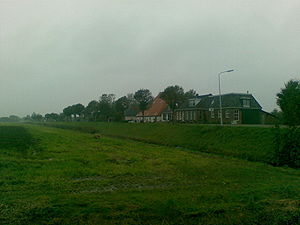
Oude Bildtdijk
Encyclopedia

Het Bildt
het Bildt is a municipality in the province of Friesland in the northern Netherlands; its capital is Sint Annaparochie. As of 1 November 2006 it had a population of 10,975. Het Bildt has 15.4 kilometers of coastline...
, built in the 16th century, to protect the new lands from flooding. Het Bildt once was part of the Middelzee
Middelzee
The Middelzee , also called Bordine, was the estuary mouth of the River Boorn now in the Dutch province of Friesland. It ran from as far south as Sneek northward to the Wadden Sea and marked the border between main Frisian regions of Westergoa and Eastergoa...
and even until this day land silts up and new lands are being given by the Waddenzee. This dike was the first barrier to protect the Bildt area from the sea.
The Nieuwe Bildtdijk
Nieuwe Bildtdijk
The Nieuwe Bildtdijk, "Nije dyk" in the local language of "Het Bildts", is a dike in the Dutch county Het Bildt which was built around the year 1600 and was to protect the land from flooding. It protected the Wester Bildtpollen and the Ooster Bildtpollen from the Waddenzee. A new higher and...
that was built in the 17th century made the Oude Bildtijk lose its protective function. Also, the Nieuwe Bildtdijk eventually lost its function when an even higher and stronger dike was thrown up in the 20th century. Nowadays, a narrow road runs over the dike and many houses and farmhouses are situated (mainly on the northern side) along and of this dike. From the year 1546, under the rule of emperor Carl V, it was only allowed to build houses on the northern side of the dikes. Only with approval of the emperor was it allowed to build on the south side. Not more than two houses have been built on the south side, of which only one still exists this day, number 237. This rule was to protect the precious land from housing, so it would be used for farming only.
With a distance of 14 kilometers, the Oude Bildtdijk is the longest street of Friesland
Friesland
Friesland is a province in the north of the Netherlands and part of the ancient region of Frisia.Until the end of 1996, the province bore Friesland as its official name. In 1997 this Dutch name lost its official status to the Frisian Fryslân...
and The Netherlands.

